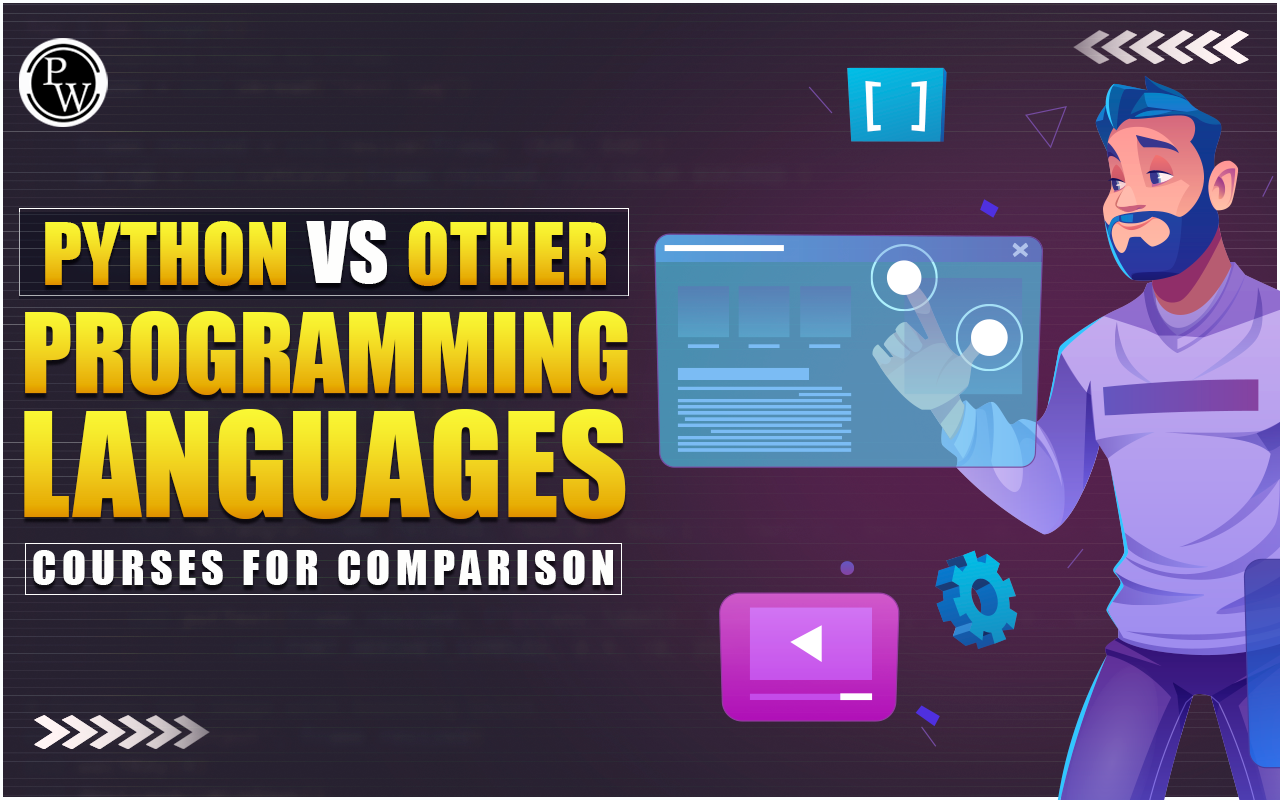Difference Between Python and Other Languages: In a world filled with programming languages, Python stands out—powerful yet easy to read, versatile yet focused. However, the coding industry is full of other programming languages that are at par with python. So, in this blog, we’ll talk about the difference between python and other languages!
If you want to secure a high-paying job in the field of Python or Machine Learning then a course could really help you a lot!
Why Python?

Python’s meteoric rise can be attributed to several key factors. Its clean and readable syntax makes it an ideal language for beginners, while its versatility and power cater to the needs of seasoned developers. Python’s extensive standard library and thriving community contribute to its widespread adoption in various domains, from web development to data science and artificial intelligence.
Difference Between Python and Golang
Go, or Golang, arose from Google to fix issues in other languages related to concurrency and performance. Its appeal lies in its simplicity, efficiency, and quick compilation.
Python’s syntax is known for its readability, making it a favourite among developers. Golang, while also prioritising simplicity, adopts a minimalist syntax. It eliminates unnecessary features and boilerplate code, making it concise and efficient.
Python faces speed criticisms compared to languages like C or C++. Golang, on the other hand, compiles to machine code for faster execution, especially in critical performance scenarios like distributed systems and microservices.
Python is favoured for rapid application development and scripting due to its simplicity. Golang shines in scenarios that demand high performance and scalability, such as backend development for large-scale applications and systems programming.
Difference Between Python and C Language

C, developed in the early 1970s, is a low-level language known for its efficiency and direct control over hardware. It has been the foundation for many modern programming languages.
Python’s high-level abstractions and readable syntax differ from C’s low-level nature, which necessitates a deep grasp of memory management. Python’s user-friendly nature appeals to beginners, whereas C demands a more in-depth comprehension of system architecture.
Python employs automatic memory management, freeing developers from manual memory allocation concerns. In C, manual memory management provides more control but requires careful handling to avoid memory-related bugs.
Python, favoured for its simplicity and speedy development, suits various applications. Meanwhile, C, prized for low-level control, excels in system-level programming, operating systems, and embedded systems.
Difference Between Python and JavaScript
JavaScript is a versatile scripting language primarily used for building dynamic web pages. It’s executed in the browser, enabling interactive and responsive user interfaces.
Python’s readability and extensive libraries make it a popular choice for scripting and automation tasks. JavaScript, being the language of the web, is indispensable for front end scripting, providing dynamic and interactive user experiences.
Python dominates backend work via frameworks such as Django and Flask. JavaScript, coupled with Node.js, widens its reach to server-side scripting. This empowers developers to employ one language for both frontend and backend tasks.
Python and JavaScript both have large and active communities with rich ecosystems. Python’s community spans various domains, while JavaScript’s strength lies in its dominance in web development.
Difference Between Python and Node.js
Node.js, grounded on the V8 JavaScript engine, functions chiefly as a runtime for running server-side code. Python, a versatile language, extends its utility beyond web development.
Server-Side Scripting and Asynchronous Programming
Node.js excels with its event-driven, non-blocking setup, ideal for managing many connections simultaneously. Python, though capable of asynchronous programming, might not outperform Node.js in certain situations.
Scalability and Performance Considerations
Node.js’s event-driven design boosts scalability, making it a top pick for real-time applications. Meanwhile, Python’s adaptability lets it scale effectively across diverse application domains.
Use Cases and Scenarios Favouring One Over the Other
Node.js is preferred for real-time apps like chats and collaboration tools. Python, known for its libraries and user-friendliness, stands out in data science, machine learning, and diverse applications.
Difference Between Python and Java

Java, developed by Sun Microsystems in the mid-1990s, is known for its “write once, run anywhere” philosophy, emphasising platform independence.
Python’s concise syntax contrasts with Java’s more verbose nature. Java, being statically typed, provides better performance and memory management than Python. Automatic memory management in both languages reduces the risk of memory-related issues.
Python’s appeal lies in its readability and simplicity, fitting well for data analysis and scripting. Java’s prowess in performance and platform neutrality makes it perfect for extensive enterprise apps, mobile development (Android), and server-side use.
Difference Between Python and Ruby
Ruby, born in the mid-’90s, earns praise for its sleek syntax, clarity, and object-oriented traits. Its fame in web development rises, thanks to the Ruby on Rails framework.
Both Python and Ruby prioritise readability, but Ruby’s syntax is often considered more elegant and expressive. Python’s simplicity may be favoured in scenarios where explicitness and clarity are paramount.
Python and Ruby share object-oriented roots, but Ruby sticks more closely to a pure object-oriented style. Python, though object-oriented, embraces procedural and functional programming styles too.
Python boasts a larger community and a broader range of libraries and frameworks. Ruby, with its smaller but passionate community, is especially strong in web development, thanks to the Ruby on Rails framework.
Difference Between Python and PHP
PHP, initially designed for web development, is a server-side scripting language embedded in HTML. It’s particularly effective for creating dynamic web pages.
Web Frameworks
Python boasts web frameworks like Django and Flask; PHP, on the other hand, features Laravel and Symfony. Selection often hinges on a developer’s familiarity with the framework and project-specific needs.
Performance Considerations for Web Applications
While both Python and PHP are suitable for web development, Python’s broader range of applications may make it a more versatile choice. PHP, tailored specifically for web development, can be highly efficient in that context.
Use Cases Where One Language May Be Preferred Over the Other
Python’s adaptability suits various uses, notably web development. PHP, deeply tied to web development, stands firm for projects favouring the LAMP stack (Linux, Apache, MySQL, PHP/Python/Perl).
Difference Between Python and R
R, developed for statistical computing and graphics, has gained popularity in data analysis, machine learning, and scientific research.
Data Analysis and Machine Learning
Both Python and R handle data analysis and machine learning, yet Python’s flexibility surpasses mere statistics. Its rich libraries, such as NumPy, Pandas, and scikit-learn, position it as a force in the data science realm.
Libraries and Ecosystems Supporting Data Science in Each Language
Python’s data science realm is extensive and varied, catering to various applications. R, with its robust ecosystem, stands out in statistical analysis, garnering favour among statisticians and researchers.
Use Cases Where Python or R Excels in Data-Related Tasks
Python is often the go-to language for data science due to its broader application domains. R, with its statistical focus, is preferred when specialised statistical analysis and visualisation are the primary requirements.
Difference Between Python and C++
C++ expands on C, including extra features. It backs object-oriented, procedural, and generic programming. Used extensively in system-level programming, game development, and high-performance apps.
Performance and Memory Management
Python differs with dynamic typing and automatic memory management, opposite to C++ with static typing and manual memory control. C++ offers detailed system resource control, fitting for performance-focused applications.
Use Cases for Systems Programming and Embedded Systems
While Python excels in rapid development and scripting, C++ is preferred for scenarios where performance, memory efficiency, and low-level control are critical. This makes C++ a top choice for systems programming, game development, and embedded systems.
Differences in Language Features and Paradigms
Python values simplicity and easy understanding, embracing procedural, object-oriented, and functional programming. In contrast, C++ has a more intricate syntax, allowing for diverse programming approaches, offering developers increased flexibility.
Python vs. C#
Overview of C#’s Role in .NET Development
C#, developed by Microsoft, is a statically-typed language primarily used for building Windows applications, web applications, and services within the .NET framework.
Comparing Python and C# for Application Development
Python’s versatility extends to application development, but C# is particularly powerful within the .NET ecosystem. The choice often depends on the target platform and specific requirements.
Differences in Syntax, Platform Support, and Performance
Python’s concise syntax contrasts with C#’s more structured and statically-typed nature. C# is optimised for the .NET platform, providing seamless integration with Microsoft technologies.
Considerations for Choosing One Language Over the Other in Specific Scenarios
C# is often the preferred choice for Windows application development and projects within the .NET ecosystem. Python, with its cross-platform capabilities, may be chosen for its versatility in a broader range of applications.
How Does Python Compare to Other Programming Languages?
Python’s unique design philosophy and characteristics distinguish it from other programming languages. Understanding these key differences provides insights into the situations where Python excels and where alternative languages may be more suitable.
Dynamic Typing and Readability
Python’s dynamic typing allows for flexibility in variable types, making it more concise and readable. In contrast to statically typed languages like Java or C++, where variable types need explicit declaration, Python determines types during runtime. This boosts code readability and cuts down on unnecessary code, adding to Python’s image as an easily learnable and user-friendly language.
Whitespace and Indentation
Python’s unique coding trait involves using whitespace and indentation for structure, diverging from languages like C, Java, or JavaScript that employ braces or keywords for code blocks. Indentation in Python enforces a uniform coding style, ditching unnecessary characters and prioritising clear, readable code.
Interpreted Nature vs. Compilation
Python, an interpreted language, runs code line by line when executed, differing from compiled languages like C++ or Java. In Python, code translates into machine-readable binary during runtime. While interpreted languages offer flexibility, compiled languages often provide better performance. Python’s interpreted nature contributes to its ease of use but may come at the cost of execution speed in certain scenarios.
GIL (Global Interpreter Lock)
Python’s Global Interpreter Lock (GIL) is a notable characteristic that influences its performance in multi-threaded environments. The GIL ensures that only one thread executes Python bytecode at a time, limiting the effectiveness of multi-core processors in certain scenarios. This can impact Python’s performance in CPU-bound tasks compared to languages like Golang or C++ that handle parallelism differently.
Versatility and Use Cases
Python’s versatility is a defining feature. It is a versatile language, fitting various applications, including web development, data science, and machine learning. While languages like JavaScript shine in front-end web development and R in statistical analysis, Python’s broad scope is notable. Python’s broad applicability makes it a popular choice for developers working across diverse fields.
Memory Management
Python’s memory is managed automatically by the Python memory manager, unlike C or C++, where developers exert more control over memory tasks. Though Python’s automatic memory handling eases development, it can result in higher memory consumption compared to languages with manual control.
Also Check: Time Series Analysis in Data Science: A Step-by-Step Guide
Community and Ecosystem
Python’s large and active community contributes to its success. The abundance of third-party libraries and frameworks enhances development speed and allows Python developers to leverage existing solutions. Developers favour Python for its strong community support and abundant resources like documentation and tutorials. The language provides a collaborative and well-supported environment for those seeking efficient development.
Object-Oriented Paradigm
Embracing an object-oriented programming approach, Python highlights the significance of classes and objects. This aligns with design principles found in languages like Java and C#, setting it apart from more procedurally oriented languages such as C. Python’s object-oriented nature eases code organisation and promotes reusability, enhancing its overall maintainability.
Platform Independence
Python’s “write once, run anywhere” philosophy is akin to Java’s. Python code is platform-independent, meaning it can run on various operating systems without modification. This stands in contrast to languages like C, where code may need adjustments for different platforms. The portability of Python code simplifies deployment and maintenance.
Difference between Python and Other Languages Interview Questions
Interviews are a crucial gateway for developers to showcase their skills and understanding of programming languages. The following interview questions delve into the nuances that distinguish Python from other languages, providing interviewers with insights into a candidate’s depth of knowledge.
How does Python’s memory management differ from languages like C and C++?
Python employs automatic memory management (garbage collection), relieving developers from manual memory allocation and deallocation. In contrast, languages like C and C++ require explicit memory management, making them more error-prone but also providing greater control over system resources.
Discuss the differences in syntax between Python and Java.
Java is statically typed, requiring variable types to be declared explicitly, while Python is dynamically typed, inferring variable types at runtime. Understanding these differences is crucial for developers transitioning between these languages.
Explain the concept of Global Interpreter Lock (GIL) in Python and its implications.
Python’s GIL ensures that only one thread executes Python bytecode at a time, impacting the language’s performance in multithreaded applications. Compare this with languages like Java, which leverage multithreading more efficiently.
What are the major differences in how error handling is approached in Python and JavaScript?
Python relies on exceptions for error handling, while JavaScript uses a combination of exceptions and call-back functions. Understanding the strengths and weaknesses of each approach is vital for developers working in both languages.
Compare Python’s approach to object-oriented programming with that of C++.
Python supports multiple inheritance, dynamic typing, and encapsulation, providing a more flexible approach to object-oriented programming. In contrast, C++ is statically typed and enforces stricter encapsulation and type hierarchy.
Discuss the role of interpreters and compilers in Python, Java, and C++
Python is an interpreted language, executing code line by line, while Java and C++ are compiled languages, where the entire code is translated into machine code before execution. Understanding this fundamental distinction is essential for developers working in diverse language ecosystems.
How does Python’s list comprehension differ from similar constructs in languages like Ruby or JavaScript?
Python’s list comprehensions provide a concise way to create lists, showcasing the language’s readability. Compare this with Ruby or JavaScript, which have their syntax for achieving similar outcomes, but with subtle differences in approach.
Examine the role of a virtual environment in Python and its counterparts in other languages.
Python’s virtual environments enable the isolation of dependencies, fostering project scalability. Compare this with equivalents in languages like Node.js or Ruby, understanding how each language manages dependencies and avoids conflicts.
Also read: Bubble Sort Algorithm
Discuss the impact of Python’s “batteries included” philosophy on development compared to languages like Go.
Python’s extensive standard library provides a wide array of modules, following the “batteries included” philosophy. In contrast, Go emphasises simplicity and minimalism, requiring developers to import only what they need. Assess the implications of these approaches on project development.
How do Python decorators differ from similar concepts in languages like Java or C#?
Python decorators are a powerful feature for modifying or extending the behaviour of functions or methods. Compare this with Java or C#, where similar functionality might be achieved through annotations or attributes, exploring the syntax and use cases in each language.
Conclusion
In the realm of programming languages, Python gracefully balances simplicity and power. From its elegant contrast with Golang to its synchronous dance with Node.js, Python’s versatility shines. Interview insights offer guidance, emphasising the nuanced choices in language selection.
As Python influences and echoes in other language designs, it stands not as a cure-all but a versatile tool. Whether you’re a dedicated Pythonista or a polyglot explorer, success lies in aligning your language choice with project needs.
If you want to make a successful career in data science or Python, then the PW Skills Decode Data Science With Machine Learning 1.0 course could be highly beneficial for you! So, don’t wait! Enrol now!
Difference Between Python and Other Languages FAQs
Is Python only suitable for beginners?
No, Python's simplicity caters to beginners, but its versatility and extensive libraries make it powerful for seasoned developers in domains like AI, data science, and web development.
How does Python handle concurrency compared to Golang?
Python's simplicity contrasts with Golang's focus on concurrency; Python relies on multi-threading, while Golang's goroutines provide efficient concurrency management.
Why choose C++ over Python for performance-critical applications?
C++ excels in performance-critical scenarios due to its compiled nature, efficient memory management, and low-level control, making it ideal for resource-intensive applications.
In what scenarios should I prefer Java over Python?
Java's platform independence and robust ecosystem make it ideal for large-scale enterprise applications, especially when cross-platform compatibility and scalability are crucial.
How does JavaScript complement Python in full-stack development?
Python is often used for server-side logic, while JavaScript dominates the frontend. Together, they create a seamless full-stack development environment with Python in the backend and JavaScript in the frontend.
What advantages does Node.js offer over Python for server-side development?
Node.js's event-driven, non-blocking architecture makes it well-suited for handling concurrent requests, offering high responsiveness in scenarios where Python's synchronous execution might face limitations.
Why might one choose Ruby over Python for web development?
Ruby's minimalist philosophy and elegant syntax appeal to developers seeking simplicity. It often shines in web development projects, offering a different approach compared to Python.
Can PHP be used for applications other than web development?
While PHP is primarily designed for web development, it can be used for general-purpose scripting. Python, with its broader application domains, remains more versatile for non-web scenarios.
How does R compare to Python in statistical analysis?
Python is renowned for its broad ecosystem in data science and machine learning, while R stands out for its statistical prowess, making it a preferred choice for statisticians and researchers.
Why does C# stand out in enterprise development compared to Python?
C# is particularly strong in Windows-centric environments and enterprise development, seamlessly integrating with the .NET framework, providing robust tooling and support.





